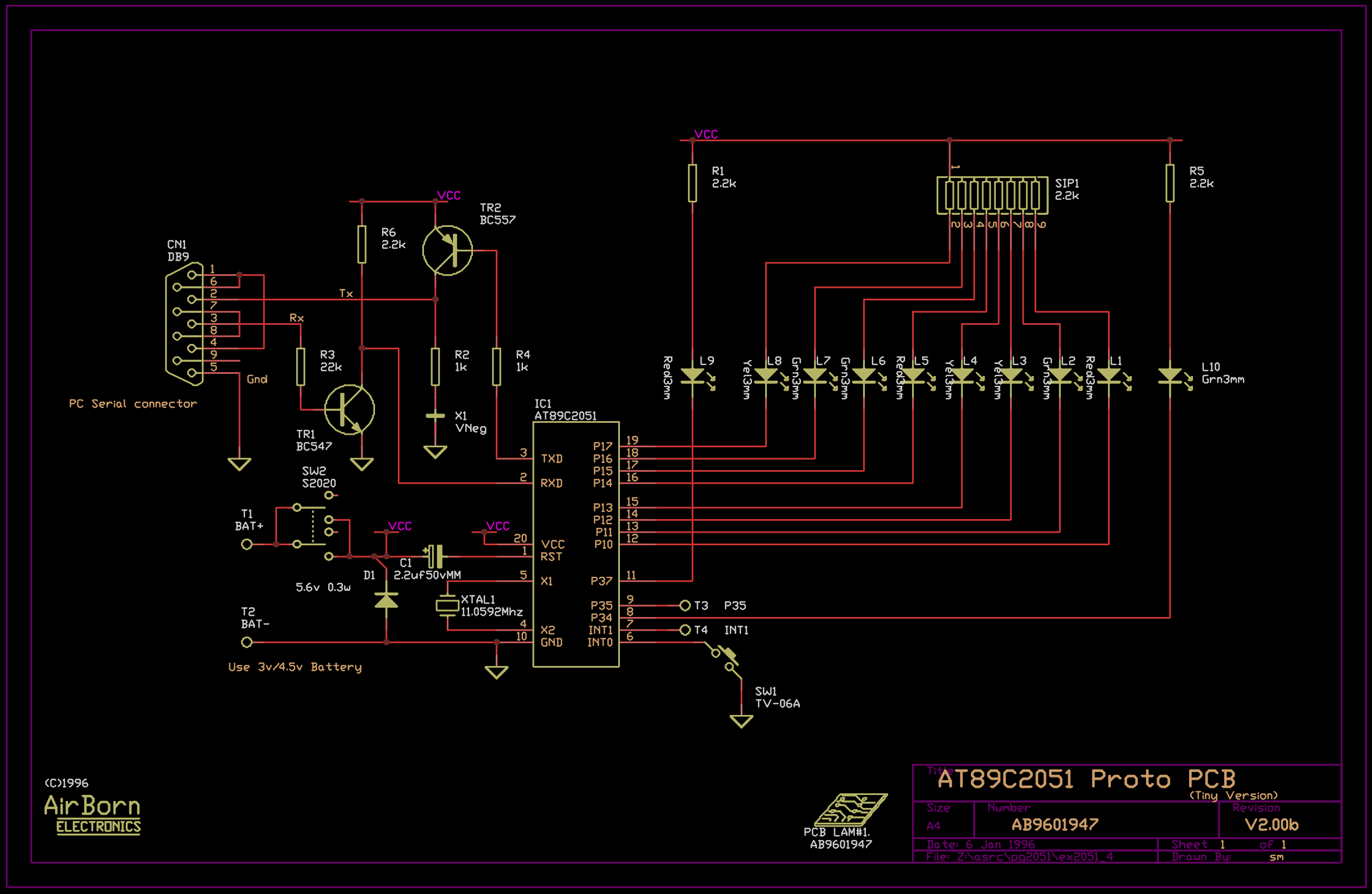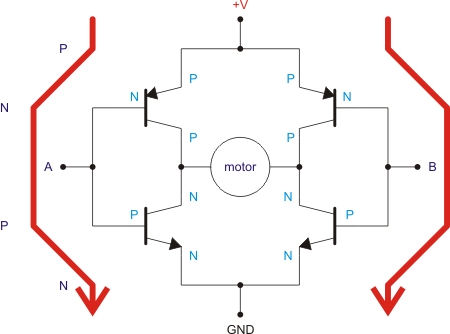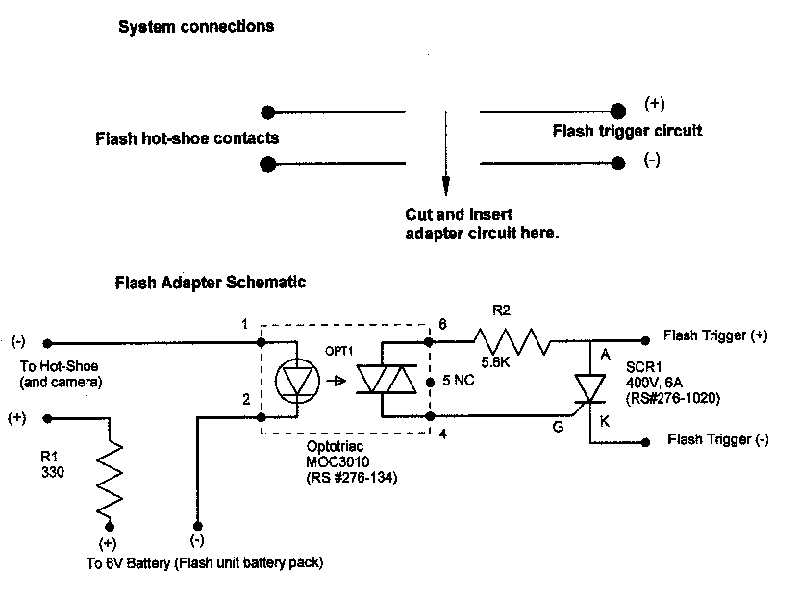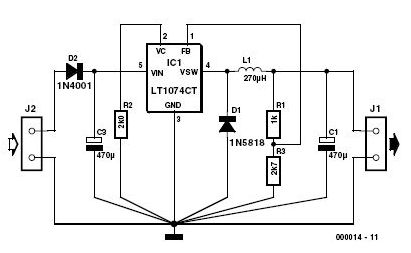
Four Port Serial Adapter for the EB675001DIP
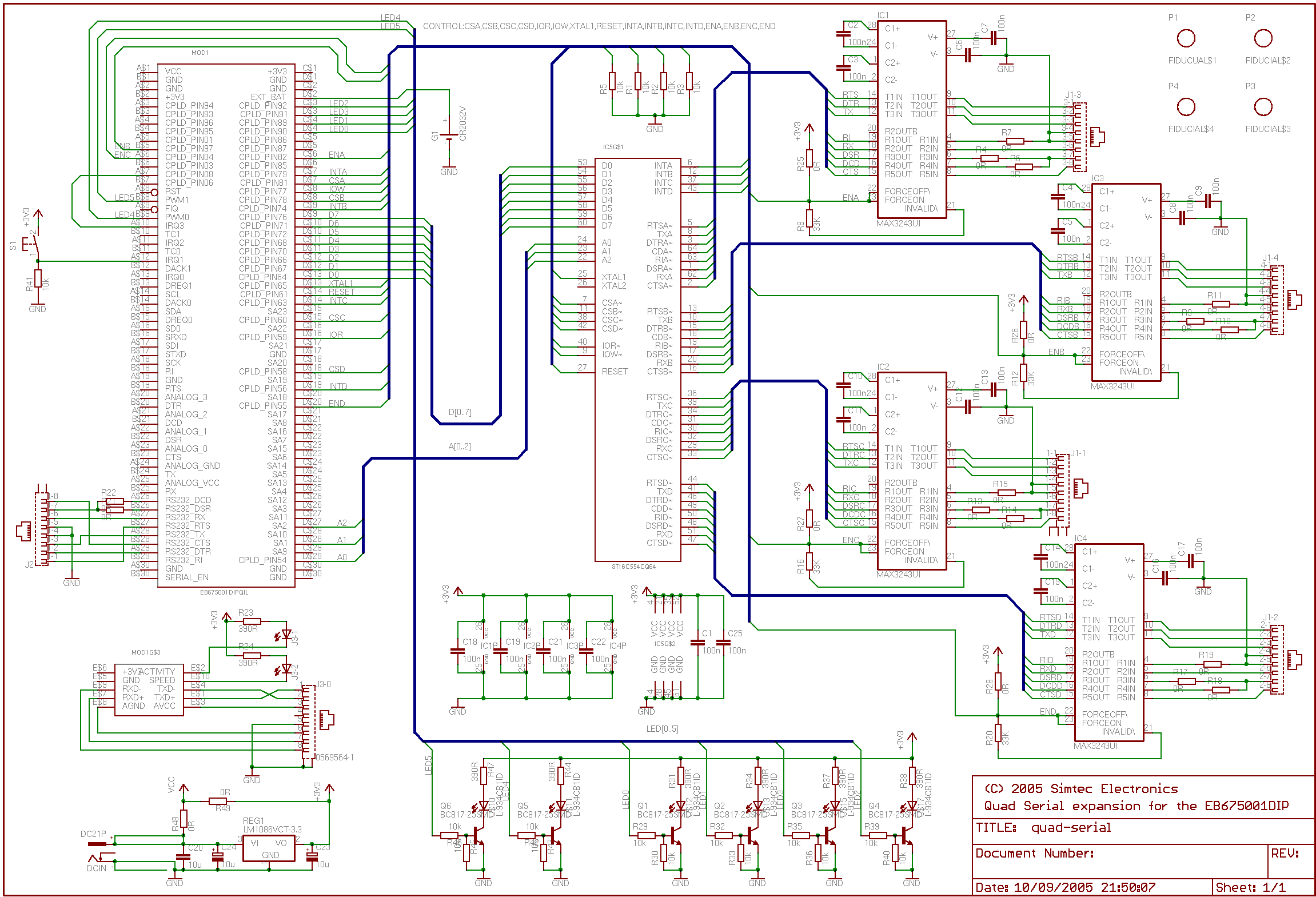
This application note details the integration of a quad serial controller into the EB675001 Module. A multi-source quad Universal Asynchronous Receiver and Transmitter (UART), specifically the 16554 type, was chosen to facilitate component sourcing and implementation. The RS232 line drivers were similarly selected. The UART connects to the system via the user-programmable CPLD, eliminating the need for additional logic. Serial communications involve transmitting data one bit at a time over a single communication channel, typically by varying the voltage on a wire between two computers. Common examples of serial peripheral buses in computing include USB, Firewire, and RS232, with this design specifically tailored for RS232 type serial ports. Given the prevalence of RS232 serial peripherals in computing, it is often desirable to access multiple devices over a network, typically using an Ethernet connection. The RS232 bus usually operates in asynchronous mode, where data is transmitted without a regular clock signal. Data is sent as a series of seven or eight-bit wide values, each transmitted as a binary level between start and stop bits. The data is sampled at a predetermined rate, triggered by the arrival of the start bit. The RS232 specification outlines the required voltages and physical characteristics. Due to the standard's commonality, simple devices known as line drivers exist to implement it with minimal additional circuitry. Asynchronous signals are typically generated using a Universal Asynchronous Receiver and Transmitter (UART), which connects to the computer's I/O bus. The proposed design includes a quad UART and four line drivers connected to the EB675001DIP module through its user-programmable CPLD for all necessary decoding and timing logic. The 16554 device comprises four 16550-style UARTs in a single package, allowing for four independent high-speed (maximum 921600 baud) asynchronous serial ports. The addition of RS232 compatible line drivers results in a total of five RS232 serial ports, as the EB675001DIP module already includes a 16550-style UART and line driver. A compact design was prioritized, leading to the selection of a small 64-pin TQFP package (measuring 10mm x 10mm). Larger packaging options, such as a 68-pin PLCC package, are available but do not impact the overall design. The UART is available in a 3.3V supply, 64-pin TQFP package from various suppliers, with the Exar ST16C554D being selected, though alternatives like Twist Semiconductor TG16C554, EPIC Semiconductor Ei16C554, or Philips SC16C554D also exist (noting reported issues with IRQ handling on the Philips part). The RS232 line drivers were chosen for size and availability from multiple suppliers, with the Texas Instruments SN75C3243 selected, while alternatives like MAXIM MAX3243 are also available. If additional ports are required, a second UART can be added. All data, address, and control lines, except for chip selects, can be connected in parallel to the second UART, necessitating additional decoding within the CPLD to assert the correct chip selects. The schematic represents a specific design based on the general ideas previously outlined. The design was created by establishing data, address, and control buses and connecting the UART to them. The four line drivers were wired to the UART and RJ45 connectors. The schematic was developed using the "light" version of the Cadsoft EAGLE package, demonstrating the capabilities of freely available software on a single page with the flexibility of the EB675001DIP module. The complete schematic diagram is straightforward and adheres to the logical layout as previously detailed.
The circuit design incorporates a quad UART (Universal Asynchronous Receiver/Transmitter) and RS232 line drivers, facilitating multiple serial communication channels. The quad UART, specifically the 16554 type, is capable of managing four independent asynchronous serial ports, each supporting a maximum baud rate of 921600. This high-speed capability is essential for applications requiring rapid data exchange.
The RS232 line drivers are crucial for ensuring that the signals conform to the RS232 standard, which specifies voltage levels for signaling. The chosen line drivers, such as the Texas Instruments SN75C3243, are compact and available in a 28-pin TSSOP package, allowing for efficient integration into the overall design.
The use of a user-programmable CPLD (Complex Programmable Logic Device) simplifies the design by eliminating the need for additional logic components. This CPLD handles all necessary decoding and timing functions, streamlining the connection between the UART, line drivers, and the system's data buses.
In terms of physical layout, the design prioritizes compactness, utilizing a 64-pin TQFP package for the quad UART. This choice balances size and functionality, enabling the integration of multiple serial ports within a confined space. The schematic layout created using Cadsoft EAGLE software allows for a clear representation of the connections and components involved, providing an accessible reference for implementation.
Overall, this design addresses the need for multiple RS232 serial ports in a compact and efficient manner, leveraging established components and standards to achieve robust performance in serial communications.This application note describes the addition of a quad serial controller to the EB675001 Module. A multi source quad Universal Asyncronous Reciver and Transmitter (UART), 16554 type, was selected to ease implementation and sourcing of components. The RS232 line drivers were similarly selected. The UART is connected to the system by using the user CPLD which removes the need for any additional logic. Serial communications are those where data is transmitted one bit at a time along a single communication channel, typically varying a voltage on a piece of wire between two computers. Serial peripheral buses within computing are very common, examples of some are USB, Firewire and RS232 This design is for RS232 type serial ports.
There are a large number of RS232 serial peripherals used within the computing world and it is often desirable to access several of them over a network typically using an Ethernet connection. The RS232 bus is almost always used in its asynchronous mode of operation that is a mode where the data is transmitted without a regular clock signal.
The data to be sent is presented as a series of seven or eight bit wide values, each value is trasmitted as a binary level between start and stop bits. The data is sampled at a pre-determined rate and is triggered by the arrival of the start bit. The RS232 specification also defines the voltages and physical requirements. Because the standard is so common simple devices exist, called line drivers, which implent it with minimal additional circuitry.
The asyncronous signals are typicaly generated with a Universal Asynchronous Receiver and Transmitter (UART) this device connects to the computers I/O bus. The proposed design is a quad UART and four line drivers attached to the EB675001DIP module using its user programmable CPLD to perform all the necessary decode and timing logic.
The 16554 device is four 16550 style UARTs in a single package which allows for four independent high speed (921600 baud maximum) asynchronous serial ports. The addition of RS232 compatible line drivers provides a total of five RS232 serial ports (the EB675001DIP module has a 16550 style UART and line driver already built in).
A compact design was desired for this solution so a small 64pin TQFP package was selected (this measures 10mm x 10mm). Other physically larger packaging options exist e. g. a 68 pin PLCC package which should not affect the overall design. The UART is available in the 3. 3V supply, 64pin TQFP package from a number of suppliers, we have selected the Exar ST16C554D but alternatives exist such as Twist Semiconductor TG16C554, EPIC Semiconductor Ei16C554 or Philips SC16C554D (note there have been some issues reported with IRQ handling on the Philips part - use with caution) The RS232 line drivers are similarly selected for size and multiple source supply.
The line drivers are available in 28pin TSSOP package from a number of suppliers, we have selected the Texas Instruments SN75C3243 but alternatives such as MAXIM MAX3243 exist. If more ports were desired they could be added with a second UART. All data, address and control lines except the chip selects can be connected in parallel to the second UART.
Some additional decoding within the CPLD to assert the correct chip selects would also be required. The schematic creates a specific design from the general ideas outlined previously. The design was generated directly by creating data, address and control buses and connecting the UART to them. The four line drivers were then wired to the UART and to the RJ45 connectors. The schematic was created with the "light" version of the Cadsoft EAGLE package. This schematic layout package was used to demonstrate what can be achieved with freely available software on a single page with the flexibility of the EB675001DIP module.
The complete schematic diagram is straightforward and adheres to the logical layout as detailed previousl 🔗 External reference
The circuit design incorporates a quad UART (Universal Asynchronous Receiver/Transmitter) and RS232 line drivers, facilitating multiple serial communication channels. The quad UART, specifically the 16554 type, is capable of managing four independent asynchronous serial ports, each supporting a maximum baud rate of 921600. This high-speed capability is essential for applications requiring rapid data exchange.
The RS232 line drivers are crucial for ensuring that the signals conform to the RS232 standard, which specifies voltage levels for signaling. The chosen line drivers, such as the Texas Instruments SN75C3243, are compact and available in a 28-pin TSSOP package, allowing for efficient integration into the overall design.
The use of a user-programmable CPLD (Complex Programmable Logic Device) simplifies the design by eliminating the need for additional logic components. This CPLD handles all necessary decoding and timing functions, streamlining the connection between the UART, line drivers, and the system's data buses.
In terms of physical layout, the design prioritizes compactness, utilizing a 64-pin TQFP package for the quad UART. This choice balances size and functionality, enabling the integration of multiple serial ports within a confined space. The schematic layout created using Cadsoft EAGLE software allows for a clear representation of the connections and components involved, providing an accessible reference for implementation.
Overall, this design addresses the need for multiple RS232 serial ports in a compact and efficient manner, leveraging established components and standards to achieve robust performance in serial communications.This application note describes the addition of a quad serial controller to the EB675001 Module. A multi source quad Universal Asyncronous Reciver and Transmitter (UART), 16554 type, was selected to ease implementation and sourcing of components. The RS232 line drivers were similarly selected. The UART is connected to the system by using the user CPLD which removes the need for any additional logic. Serial communications are those where data is transmitted one bit at a time along a single communication channel, typically varying a voltage on a piece of wire between two computers. Serial peripheral buses within computing are very common, examples of some are USB, Firewire and RS232 This design is for RS232 type serial ports.
There are a large number of RS232 serial peripherals used within the computing world and it is often desirable to access several of them over a network typically using an Ethernet connection. The RS232 bus is almost always used in its asynchronous mode of operation that is a mode where the data is transmitted without a regular clock signal.
The data to be sent is presented as a series of seven or eight bit wide values, each value is trasmitted as a binary level between start and stop bits. The data is sampled at a pre-determined rate and is triggered by the arrival of the start bit. The RS232 specification also defines the voltages and physical requirements. Because the standard is so common simple devices exist, called line drivers, which implent it with minimal additional circuitry.
The asyncronous signals are typicaly generated with a Universal Asynchronous Receiver and Transmitter (UART) this device connects to the computers I/O bus. The proposed design is a quad UART and four line drivers attached to the EB675001DIP module using its user programmable CPLD to perform all the necessary decode and timing logic.
The 16554 device is four 16550 style UARTs in a single package which allows for four independent high speed (921600 baud maximum) asynchronous serial ports. The addition of RS232 compatible line drivers provides a total of five RS232 serial ports (the EB675001DIP module has a 16550 style UART and line driver already built in).
A compact design was desired for this solution so a small 64pin TQFP package was selected (this measures 10mm x 10mm). Other physically larger packaging options exist e. g. a 68 pin PLCC package which should not affect the overall design. The UART is available in the 3. 3V supply, 64pin TQFP package from a number of suppliers, we have selected the Exar ST16C554D but alternatives exist such as Twist Semiconductor TG16C554, EPIC Semiconductor Ei16C554 or Philips SC16C554D (note there have been some issues reported with IRQ handling on the Philips part - use with caution) The RS232 line drivers are similarly selected for size and multiple source supply.
The line drivers are available in 28pin TSSOP package from a number of suppliers, we have selected the Texas Instruments SN75C3243 but alternatives such as MAXIM MAX3243 exist. If more ports were desired they could be added with a second UART. All data, address and control lines except the chip selects can be connected in parallel to the second UART.
Some additional decoding within the CPLD to assert the correct chip selects would also be required. The schematic creates a specific design from the general ideas outlined previously. The design was generated directly by creating data, address and control buses and connecting the UART to them. The four line drivers were then wired to the UART and to the RJ45 connectors. The schematic was created with the "light" version of the Cadsoft EAGLE package. This schematic layout package was used to demonstrate what can be achieved with freely available software on a single page with the flexibility of the EB675001DIP module.
The complete schematic diagram is straightforward and adheres to the logical layout as detailed previousl 🔗 External reference

